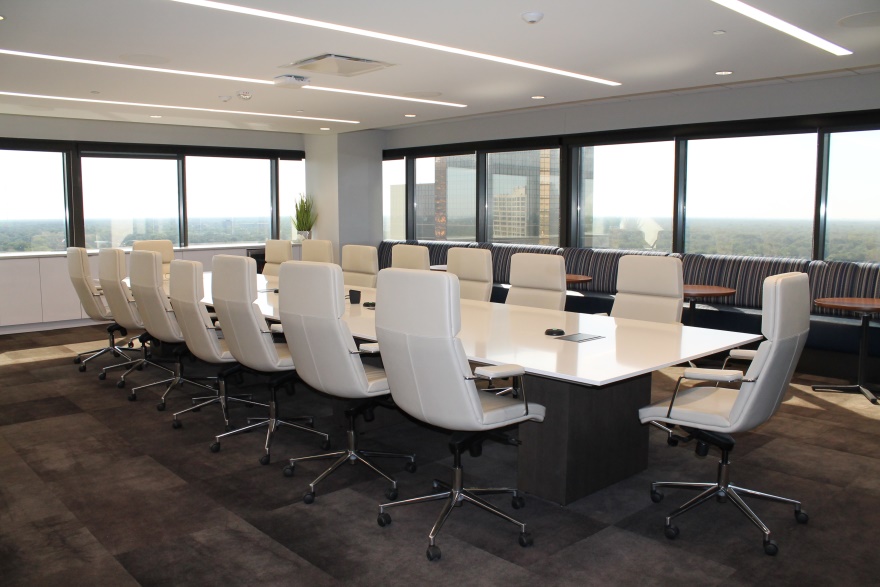None of us are strangers to meetings. If you work in the corporate world, you are bound to be called into a meeting.
According to a report by INC, executives spend about 23 hours a week in meetings on average.
Meetings help attendees to share ideas, make decisions, determine future goals and foster team bonding.
Offices need meeting rooms to conduct meetings. A meeting room creates a conducive environment to discuss matters without distractions. However, the management of meeting rooms in an office is not without its share of problems.
Without a meeting room booking system, your teams will struggle to know if a meeting space is available or not. A WSJ report states that 40% of employees spend up to three weeks a year looking for a meeting room.
A meeting room booking system can eliminate some of the booking problems but not all. A small team may book a large meeting room while larger teams may not get access to suitable meeting rooms.
A meeting room on a particular floor of the office may be booked by employees belonging to a department on that floor and they may not prefer departments on other floors to book it.
Some meeting rooms may be booked more than others or an employee may book multiple meeting rooms for one single meeting to have the option to pick and choose at the last moment. We have even seen organizations where the meeting room is booked for the whole year so that the department where the meeting room is located can use it whenever they want.
While these are very human-centric tendencies and based on the cultural environment of the office, these practices lead to tremendous wastage of space leading to resentment, conflict, and general unhappiness within the staff.
One way to try and resolve this problem is by introducing cross-departmental charging (also referred to as internal charging).
What is cross-departmental or Internal Charging?
Cross-departmental charging refers to the practice of charging department cost centers for services utilized. Typically, this form of charging originates from shared services such as marketing, printing, transportation, and consumables. Departments use these services and at the end of the month, these are billed and deducted from the department’s annual budgets.
Cross-departmental charging in a meeting room booking system refers to the practice of allocating costs associated with meeting room usage across various departments within an organization. In this case, the meeting rooms are considered shared services, and departments “rent” out the meeting rooms for use.
This approach involves integrating a charging mechanism into a centralized booking system that allows multiple departments to access and reserve meeting spaces, while keeping track of the usage.
Benefits of implementing cross-departmental charging
Let’s now explore the benefits that arise from implementing cross-departmental charging into your organization.
Resource Optimization
Cross-departmental charging ensures that meeting room resources are allocated judiciously and fairly among different departments. This eliminates the inefficiencies associated with underutilized meeting spaces in some departments while others face a shortage.
By centralizing the booking system and allowing cross-departmental access, organizations can maximize the utilization of their meeting spaces, leading to improved overall efficiency.
Cost Reduction
Efficient resource allocation naturally translates into cost savings. By avoiding unnecessary duplication of meeting room facilities and reducing the need for additional infrastructure, organizations can optimize their budgets.
Cross-departmental charging allows for a more accurate assessment of resource usage, enabling organizations to invest in what is truly needed, ultimately contributing to a leaner and more cost-effective operation.
Improved Collaboration
One of the most significant advantages of cross-departmental charging is its ability to break down silos within an organization. When different departments share access to meeting spaces, it promotes interdepartmental communication and collaboration.
This fosters a more cohesive working environment, encouraging the exchange of ideas and knowledge across diverse teams.
Enhanced Transparency
Implementing cross-departmental charging introduces a level of transparency in the allocation of resources. Each department can view the availability of meeting rooms, understand usage patterns, and contribute to the overall efficiency of the organization.
This transparency not only helps in preventing conflicts but also promotes a culture of accountability, as departments become more aware of their resource consumption.
Data-Driven Decision-Making
Cross-departmental charging generates valuable data on meeting room usage, patterns, and peak times. This data can be leveraged for informed decision-making, such as optimizing working hours, adjusting resource allocation based on demand, and planning for future expansions.
With access to real-time data, organizations can adapt quickly to changing needs, making their operations more agile and responsive.
Enhanced User Experience
A unified meeting room booking system simplifies the reservation process for employees. With a centralized platform, individuals can easily locate and book available meeting spaces based on requirements, reducing the time spent on searching for an appropriate meeting room.
This user-friendly approach enhances the overall experience, contributing to increased employee satisfaction.
How to get started
While different software systems implement cross-departmental charging differently, here, we cover how this can be achieved in ecobook, our meeting room and desk booking system.
Firstly, determine the cost center to which each facility will belong. In most large organizations, meeting rooms are owned by the facilities team. For others, it can be the Human Resources, Office supplies, or even the department in which the meeting room is located.
Secondly, Populate the divisions, departments, and sections along with their cost centers. This can be done using the user interface or synchronized using APIs from a third-party system.
Thirdly, the users along with their cost centers must be included in ecobook. Again, this can be done using the interface or through our APIs. Once synchronized, ensure no user is left in the unassigned section. If there are users, then move them to the right cost center.
Fourthly, set rates for each facility. Rates can be fixed or variable rates. Also, consider the prevention of last-minute cancellations to reduce abuse of the system. If there are charges for the booking of resources, include them as well. Resources may be manpower services to set up the meeting room, catering, additional equipment, and or furniture.
The booking system tracks the usage of meeting rooms by different departments. Data on the frequency, duration, and purpose of meetings are collected to facilitate accurate cost distribution.
From the user’s perspective, there is no change in the method of booking. However, when making a booking, the calculated amounts based on the pricing policy set are shown to the user. They can choose to proceed with the booking or choose an alternative room.
Lastly, At the end of the month, administrators can generate a report and pass it on to finance for the necessary adjustments in the budget. Finance shall use this report to perform posting between the departments using the meeting rooms and the departments owning the facility. This provides funds for the facility-owned department in the upkeep of the meeting rooms.
Conclusion
The implementation of cross-departmental charging within meeting room booking systems is a strategic move that goes beyond mere resource management. It fosters collaboration, transparency, and efficiency, creating a cost-effective work environment.
As organizations continue to evolve in a rapidly changing business landscape, embracing such forward-thinking solutions becomes imperative for sustained success and growth.





